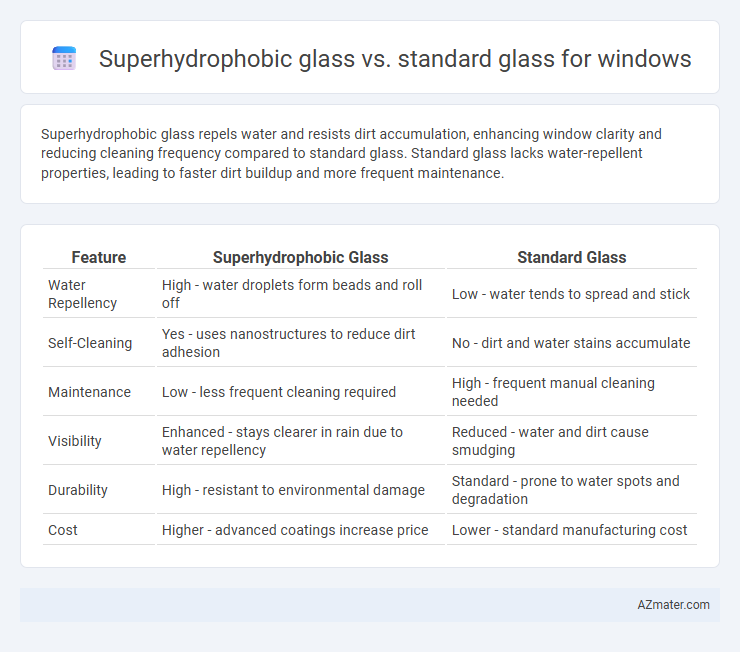Superhydrophobic glass repels water and resists dirt accumulation, enhancing window clarity and reducing cleaning frequency compared to standard glass. Standard glass lacks water-repellent properties, leading to faster dirt buildup and more frequent maintenance.
Table of Comparison
| Feature | Superhydrophobic Glass | Standard Glass |
|---|---|---|
| Water Repellency | High - water droplets form beads and roll off | Low - water tends to spread and stick |
| Self-Cleaning | Yes - uses nanostructures to reduce dirt adhesion | No - dirt and water stains accumulate |
| Maintenance | Low - less frequent cleaning required | High - frequent manual cleaning needed |
| Visibility | Enhanced - stays clearer in rain due to water repellency | Reduced - water and dirt cause smudging |
| Durability | High - resistant to environmental damage | Standard - prone to water spots and degradation |
| Cost | Higher - advanced coatings increase price | Lower - standard manufacturing cost |
Introduction to Superhydrophobic vs Standard Glass
Superhydrophobic glass features a nano-engineered surface that repels water with contact angles exceeding 150deg, significantly reducing water retention and streaks compared to standard glass. Standard glass, lacking such surface treatments, allows water droplets to spread and cling, leading to frequent cleaning and visibility issues. The advanced water-repellent properties of superhydrophobic glass enhance durability and maintain optical clarity, making it ideal for windows exposed to moisture and environmental pollutants.
What Makes Glass Superhydrophobic?
Superhydrophobic glass features a nanostructured surface coating that drastically increases water contact angles above 150 degrees, causing water droplets to bead up and roll off effortlessly, unlike standard glass that allows water to spread and adhere. This ultra-water-repellent effect is achieved through chemical treatments combined with microscopic roughness, which reduce surface energy and prevent moisture accumulation. The enhanced water repellency of superhydrophobic glass improves visibility, reduces cleaning frequency, and provides better resistance to stains and corrosion compared to standard glass used in windows.
Key Properties of Standard Glass
Standard glass for windows typically exhibits a water contact angle of around 20-30 degrees, indicating hydrophilic properties that allow water to spread and adhere to the surface. It has moderate thermal insulation but lacks self-cleaning capabilities, making it prone to water stains and dirt accumulation. The material is durable and transparent but requires frequent cleaning to maintain clarity and performance in various weather conditions.
Water Repellency and Self-Cleaning Effects
Superhydrophobic glass exhibits superior water repellency compared to standard glass, causing water droplets to bead up and roll off effortlessly, preventing water stains and reducing dirt accumulation. This enhanced water repellency also enables self-cleaning effects, as rainwater carries away dust and debris from the glass surface without the need for manual cleaning. In contrast, standard glass tends to retain water and dirt, leading to frequent maintenance and reduced clarity over time.
Durability and Longevity Comparison
Superhydrophobic glass features a nanocoating that repels water, dirt, and contaminants, significantly enhancing its durability compared to standard glass, which lacks this protective layer and is more prone to staining and weathering. The longevity of superhydrophobic glass is extended due to its self-cleaning properties and resistance to environmental degradation, reducing maintenance frequency and costs over time. Standard glass, while cost-effective initially, often requires more frequent cleaning and replacement due to surface wear and reduced clarity caused by exposure to pollutants and moisture.
Maintenance Requirements for Windows
Superhydrophobic glass significantly reduces maintenance requirements compared to standard glass by repelling water, dirt, and dust, which minimizes the frequency of cleaning. Its self-cleaning properties prevent the buildup of stains and grime, extending the lifespan of window panes and preserving clarity. Standard glass often requires regular washing and more intensive upkeep to maintain transparency and prevent water spots or mold growth.
Energy Efficiency and Visibility
Superhydrophobic glass enhances energy efficiency by significantly reducing water and dirt accumulation, maintaining optimal light transmission and reducing the need for frequent cleaning, unlike standard glass that often suffers from streaks and grime buildup, decreasing visible clarity. Its advanced water-repellent coating prevents moisture retention and heat loss, resulting in better insulation and lower HVAC energy consumption compared to traditional window glass. Visibility remains consistently high, as the hydrophobic surface ensures minimal distortion from water droplets, improving natural daylight penetration and overall window performance in varied weather conditions.
Installation Process and Costs
Superhydrophobic glass for windows requires specialized installation techniques to maintain its water-repellent coating, often leading to higher labor costs compared to standard glass. Standard glass installation is generally straightforward and compatible with most existing window frames, resulting in lower overall expenses. The initial investment for superhydrophobic glass is significantly higher due to advanced material costs and the need for expert handling during installation.
Environmental Impact and Sustainability
Superhydrophobic glass significantly reduces water and dirt accumulation, decreasing the need for frequent cleaning with chemical detergents, which lowers water pollution and chemical runoff compared to standard glass. Its enhanced durability and self-cleaning properties contribute to longer lifespan and reduced replacement frequency, promoting resource efficiency and waste reduction. Standard glass requires more maintenance and cleaning resources, resulting in higher environmental impact over time.
Which Glass is Best for Your Windows?
Superhydrophobic glass offers superior water repellency and self-cleaning properties compared to standard glass, reducing maintenance by preventing water spots and dirt buildup. Standard glass is generally more affordable but requires frequent cleaning and can suffer from visibility issues due to water stains. For windows exposed to harsh weather or in high-pollution areas, superhydrophobic glass provides better long-term clarity and durability, making it the best choice for enhanced performance and reduced upkeep.

Infographic: Superhydrophobic glass vs Standard glass for Window
 azmater.com
azmater.com